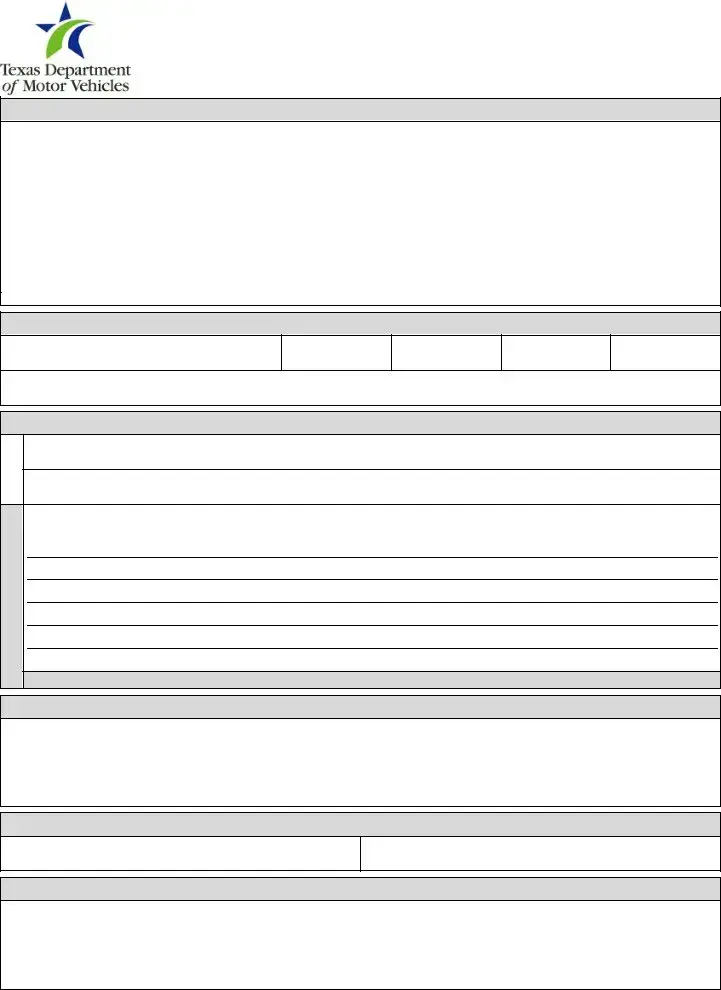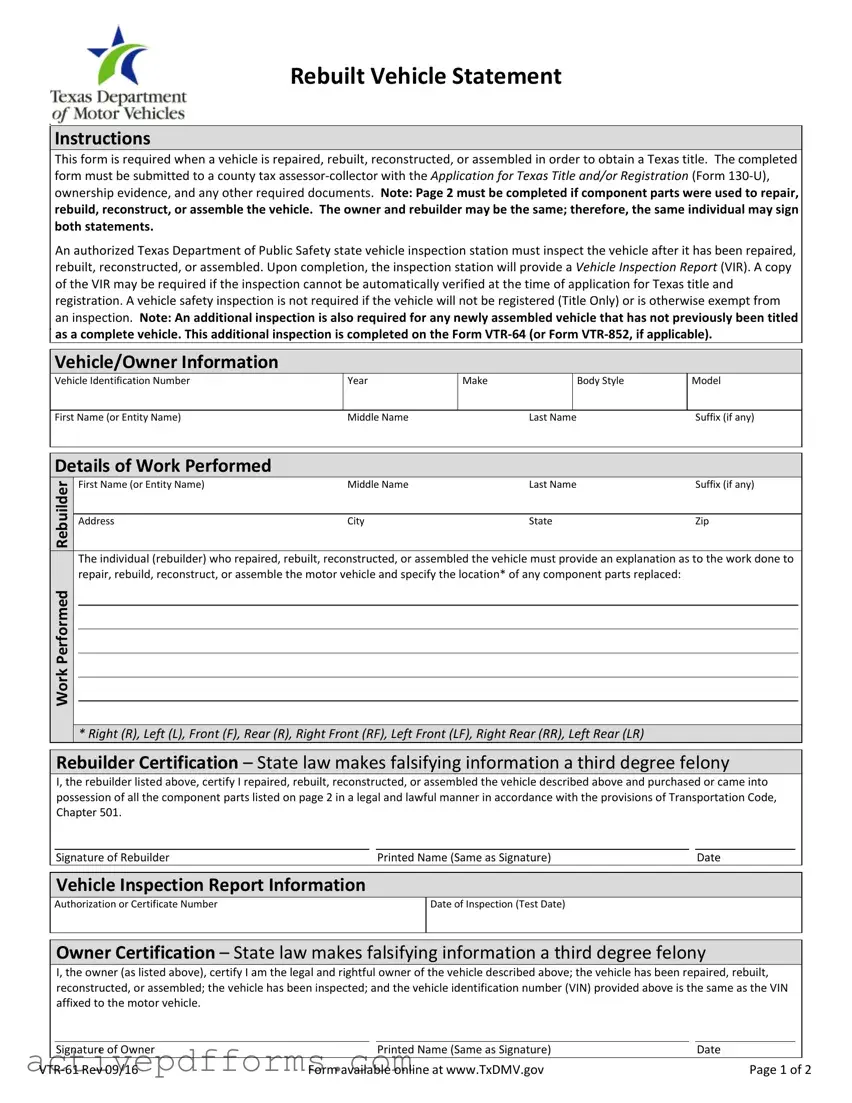
Rebuilt Vehicle Statement
Instructions
This form is required when a vehicle is repaired, rebuilt, reconstructed, or assembled in order to obtain a Texas title. The completed form must be submitted to a county tax assessor-collector with the Application for Texas Title and/or Registration (Form 130-U), ownership evidence, and any other required documents. Note: Page 2 must be completed if component parts were used to repair, rebuild, reconstruct, or assemble the vehicle. The owner and rebuilder may be the same; therefore, the same individual may sign both statements.
An authorized Texas Department of Public Safety state vehicle inspection station must inspect the vehicle after it has been repaired, rebuilt, reconstructed, or assembled. Upon completion, the inspection station will provide a Vehicle Inspection Report (VIR). A copy of the VIR may be required if the inspection cannot be automatically verified at the time of application for Texas title and registration. A vehicle safety inspection is not required if the vehicle will not be registered (Title Only) or is otherwise exempt from an inspection. Note: An additional inspection is also required for any newly assembled vehicle that has not previously been titled as a complete vehicle. This additional inspection is completed on the Form VTR-64 (or Form VTR-852, if applicable).
Vehicle/Owner Information
Vehicle Identification Number
First Name (or Entity Name)
Details of Work Performed
First Name (or Entity Name) |
Middle Name |
Last Name |
Suffix (if any) |
Address |
City |
State |
Zip |
The individual (rebuilder) who repaired, rebuilt, reconstructed, or assembled the vehicle must provide an explanation as to the work done to repair, rebuild, reconstruct, or assemble the motor vehicle and specify the location* of any component parts replaced:
* Right (R), Left (L), Front (F), Rear (R), Right Front (RF), Left Front (LF), Right Rear (RR), Left Rear (LR)
Rebuilder Certification – State law makes falsifying information a third degree felony
I, the rebuilder listed above, certify I repaired, rebuilt, reconstructed, or assembled the vehicle described above and purchased or came into possession of all the component parts listed on page 2 in a legal and lawful manner in accordance with the provisions of Transportation Code, Chapter 501.
Signature of Rebuilder |
|
Printed Name (Same as Signature) |
|
Date |
Vehicle Inspection Report Information
Authorization or Certificate Number
Date of Inspection (Test Date)
Owner Certification – State law makes falsifying information a third degree felony
I, the owner (as listed above), certify I am the legal and rightful owner of the vehicle described above; the vehicle has been repaired, rebuilt, reconstructed, or assembled; the vehicle has been inspected; and the vehicle identification number (VIN) provided above is the same as the VIN affixed to the motor vehicle.
Signature of Owner |
|
Printed Name (Same as Signature) |
|
Date |
VTR-61 Rev 09/16 |
Form available online at www.TxDMV.gov |
Page 1 of 2 |
Rebuilt Vehicle Statement
These sections must be completed by the rebuilder if the vehicle has been repaired, rebuilt, reconstructed, or assembled with any of the listed component parts.
Component Parts – Engine, Frame, and Body
|
Component Part |
|
|
Origin of Component Part/Purchased from: |
|
|
Component Part Number |
|
|
|
|
|
(Name and Complete Address) |
|
|
(required) |
|
|
|
|
|
|
|
|
|
|
|
Engine |
|
|
|
|
|
|
|
|
|
|
|
|
|
|
|
|
|
|
|
Frame |
|
|
|
|
|
|
|
|
|
|
|
|
|
|
|
|
|
|
|
Body |
|
|
|
|
|
|
|
|
|
|
|
|
|
|
|
|
|
|
|
Note: Ownership evidence (bill of sale and/or title) is required if an engine, frame, or body is used. |
|
|
|
|
|
|
|
|
|
|
|
|
|
|
Component Parts – Other |
|
|
|
|
|
|
|
Component Part |
|
|
Origin of Component Part/Purchased from: |
|
|
Component Part Number |
|
|
|
|
|
(Name and Complete Address) |
|
|
(if available) |
|
|
|
|
|
|
|
|
|
|
|
Transmission |
|
|
|
|
|
|
|
|
|
|
|
|
|
|
|
|
|
|
|
Fender(s)* |
|
|
|
|
|
|
|
|
|
|
|
|
|
|
|
|
|
|
|
Hood |
|
|
|
|
|
|
|
|
|
|
|
|
|
|
|
|
|
|
|
Door(s)* |
|
|
|
|
|
|
|
|
|
|
|
|
|
|
|
|
|
|
|
Bumper(s)* |
|
|
|
|
|
|
|
|
|
|
|
|
|
|
|
|
|
|
|
Quarter Panel(s)* |
|
|
|
|
|
|
|
|
|
|
|
|
|
|
|
|
|
|
|
Tailgate/Deck Lid/ Hatchback |
|
|
|
|
|
|
|
|
|
|
|
|
|
|
|
|
|
|
|
Pickup Cargo Box (vehicle |
|
|
|
|
|
|
|
|
|
10,000 pounds or less) |
|
|
|
|
|
|
|
|
|
Cab of a Truck |
|
|
|
|
|
|
|
|
|
|
|
|
|
|
|
|
|
|
|
Roof or Floor Pan (passenger |
|
|
|
|
|
|
|
|
|
vehicle, if separate from body) |
|
|
|
|
|
|
|
|
|
Note: Submit any bills of sale for these component parts (if any). |
|
|
|
|
|
* Specify the location of the component part on page 1 in the “Details of Work Performed” section. |
|
|
|
|
VTR-61 Rev 09/16 |
Form available online at www.TxDMV.gov |
Page 2 of 2 |


